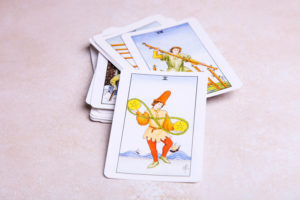Llewellyn Publications's Blog, page 10
September 28, 2023
Dark Moon Scrying Spell
Readers, please enjoy this guest blog post by Tudorbeth, author of The Hedgewitch’s Little Library, including the latest release in the series, The Hedgewitch’s Little Book of Lunar Magic.
 In my new book, The Hedgewitch’s Little Book of Lunar Magic, I discuss all manner of moon magic, including working with the colros and phases of the moon. One of the phases I love to complete magic in is the dark moon, the time when the moon cannot be seen. This is an ideal time to perform scrying and divination. These practices require us to open our minds and especially our third eye to see through the darkness. One of the things you are going to need for this spell is a phone, laptop, TV, or anything that has a black, reflective screen.
In my new book, The Hedgewitch’s Little Book of Lunar Magic, I discuss all manner of moon magic, including working with the colros and phases of the moon. One of the phases I love to complete magic in is the dark moon, the time when the moon cannot be seen. This is an ideal time to perform scrying and divination. These practices require us to open our minds and especially our third eye to see through the darkness. One of the things you are going to need for this spell is a phone, laptop, TV, or anything that has a black, reflective screen.
Scrying Spell
Scrying is a form of seeing the future or a specific time and place, and is best performed during the time of the dark moon. Traditionally, shiny or mirrored objects were used, such as black obsidian bowls that can be filled with water or mirrors themselves. In ancient times, scryers used highly polished pieces of copper.
Another way people could scry was via the crystal bowl, which is still in use today. Scryers also used a flickering candle reflected in a bowl of water, which was a favorite of Nostradamus, one of the most famous scryers in history.
However, you could use a more cost-effective method. Try your hand at scrying during the dark moon by using your phone, which has a shiny black surface and in which you can see things.
On the night of the dark moon, hold the phone in your right hand and place your left hand over it so the phone is covered. Then say:
Dark Moon, I ask for your help.
Show me what only I can see,
In my phone’s black screen.
Scrying bowls of the past,
Technology grows so fast.
I’m able to talk, see, and hear,
All that has gone before.
Past, present, and future see,
Grant me the sight of prophecy.
Remove your hand and look into the phone. Do not switch it on; you just need to look at the black screen. Focus your eyes on the images behind you as they begin to form. Although they will be behind your reflection in the phone, they are not of the past. Take note of the things you see, as they may be warnings. The black shiny screens of our phones are also great to use when you go ghost hunting or when you feel a presence. Always look into the reflection over your right shoulder.
Always enjoy the power of the moon (not just the dark moon), for our Lady is a free magical resource that can be used by everyone.
Blessed be.
Tudorbeth
Our thanks to Tudorbeth for her guest post! For more from Tudorbeth, read her article “Rainbow Moon Spells.”
September 25, 2023
Llewellyn’s Little Book of Witchcraft
Readers, please enjoy this guest blog post by Deborah Blake, author of several books, including The Everyday Witch’s Coven and the new Llewellyn’s Little Book of Witchcraft.
 I love the Llewellyn’s Little Books series, so I was thrilled when my editor suggested I might want to write one. And when it turned out that no one had covered the topic of Witchcraft yet, I immediately called dibs. Or whatever it is a dignified professional author would say under those circumstances. Snort.
I love the Llewellyn’s Little Books series, so I was thrilled when my editor suggested I might want to write one. And when it turned out that no one had covered the topic of Witchcraft yet, I immediately called dibs. Or whatever it is a dignified professional author would say under those circumstances. Snort.
A number of the other books in the series covered more specific topics, like moon spells or the Day of the Dead, but I am more of a generalist—I like to look at the big picture of a Witchcraft practice and help people to figure out how to make their own as simple, easy, and fulfilling as possible.
Additionally, I enjoy explaining the basic elements of modern Witchcraft to those who might be new to the path, sharing the things I’ve learned along the way during the many years of my own practice. I try and make things clear and accessible, and remind people that there is no one right way. Hopefully I’ve managed to do that in Llewellyn’s Little Book of Witchcraft.
The book was actually a lot of fun to write, because its style is completely different from most of my other books. There are tons of brief tips, activities, and spells, sprinkled in among the core information I thought belonged in a book about Witchcraft. Hopefully some of those things will be helpful to those who have been practicing for a while, as well as those who are new to the Craft.
What else is in the book? I’m so glad you asked. You can expect fun and interesting info on these topics:
Variations on a Witchcraft Theme: This is where I talk about a number of the different forms a Witchcraft practice can take.The Sabbats: I love me a good holiday, and this section talks about when they fall and how we celebrate them.The Lunar Cycle: Connecting with the moon is such an important part of being a witch for many of us, and this section touches on the different aspects of the lunar cycle and how they affect our practice.Special Occasions: The sabbats and the full moons aren’t the only times witches celebrate. I love a good feast, don’t you?Daily Practices: If you have read any of my other books, you will know that I like to integrate Witchcraft into my daily life, even if it is only for a few minutes a day.Witchy Crafts: Witches and crafting often go together. Why? Fun plus magic, of course.Divination: You don’t have to be a psychic to see why I’d include a section on divination in a book about Witchcraft, since so many of us witchy types practice it in one form or another.There’s even more, but I’m sure you’d rather check out the book than read about all the topics here. I hope that if you do, you discover that just because it is little, doesn’t mean it isn’t full of useful stuff that will make your practice even better.
Our thanks to Deborah for her guest post! For more from Deborah Blake, read her article “11 Things You’ll Find in Llewellyn’s Little Book of Witchcraft.”
September 21, 2023
Victorian Seasonal Spirits: The Lore of Hallowe’en, Christmas, and St. John’s Eve
Readers, please enjoy this guest blog post by Steele Alexandra Douris, author of the new Spirits, Seers & Séances.
 Those of us who enjoy the interplay of the seasonal and the spectral can learn a lot from the Victorians, whose celebrations often combined the festive and the uncanny in striking ways. The Victorians, who were obsessed with ghost legends and lore, truly had spirits for every season.
Those of us who enjoy the interplay of the seasonal and the spectral can learn a lot from the Victorians, whose celebrations often combined the festive and the uncanny in striking ways. The Victorians, who were obsessed with ghost legends and lore, truly had spirits for every season.
Christmas
In nineteenth-century England, which didn’t celebrate Hallowe’en as enthusiastically as Scotland, Ireland, or the USA, Christmas was the ghostliest holiday. Spirits were believed to be particularly active at Christmastime, and telling ghost stories around a roaring fire was a popular Christmas tradition. Charles Dickens reinforced the link between Christmas and the spirit realm with the publication of his wildly successful novella, A Christmas Carol, in 1843. Many other authors followed in his footsteps, and for years afterward, the beginning of the Christmas season heralded the publication of a deluge of seasonal ghost stories. Victorian authors had a wealth of material to draw on for their spectral tales; ghost lore varied widely by region, and many areas had their own unique legends about what sort of apparitions might stalk the snowy roads on the longest nights of the year.
St. John’s Eve
Like Christmas, St. John’s Eve falls close to a solstice: the summer solstice (in the Northern hemisphere). Celebrated on the eve of June 23, it marks the night before the feast day of St. John the Baptist, and it has some compelling ghost lore of its own. Several Victorian legends identify St. John’s Eve as a time of particularly vivid death omens or premonitions. One legend holds that on St. John’s Eve, the souls of all living people momentarily escape their bodies, and travel, over land or sea, to the exact spot where they will eventually meet their earthly demise.
Hallowe’en
Observance of Hallowe’en was spotty throughout the Victorian era; it was most popular in Ireland and Scotland, and in Irish and Scottish immigrant communities within the United States. Many modern symbols of Hallowe’en were already established in the nineteenth century: ghosts, witches, black cats, bats, and pumpkins were common motifs. However, there was also a strong connection between Hallowe’en and the fey, especially diminutive fey such as brownies and fairies (which the Victorians depicted as tiny, winged creatures). If you were ever going to catch a glimpse of the pixies or goblins populating your back garden, then it would be on Hallowe’en night. On the other hand, Hallowe’en’s modern associations with murderous maniacs, serial slashers, and sadistic killers didn’t really exist in the 19th century. Hallowe’en was a time of supernatural antics and otherworldly phantoms; dangerous human felons played little to no part in the lore of the night.
Our thanks to Steele for her guest post! For more from Steele Alexandra Douris, read her article “Six Ways Victorian Séances Were Not Like the Movies.”
September 14, 2023
Here Be Shortcuts: Christmas Kitchen Witchcraft
Readers, please enjoy this guest blog post by Linda Raedisch, author of The Old Magic of Christmas and the new Secret History of Christmas Baking.
 The Secret History of Christmas Baking took me almost two years to write. I did everything by the Old World book: candying my own orange and lemon peel, leaving my Pfefferkuchen dough to age for days in a corner of the kitchen, grating my own nutmeg, and crushing cardamom pods with my little mortar and pestle. By the time I’d sent the manuscript off to my editor, I was ready to take life easy. Don’t worry: I put a few shortcuts in the book, too. I gave you, dear reader, permission to buy already-grated nutmeg, and I included my mother’s Homestyle Lebkuchen recipe for those who aren’t ready to tackle the labor-intensive, days-long endeavor that is the traditional Elisenlebkuchen. (Lebkuchen and Pfefferkuchen are also known as, but not necessarily the same thing as, gingerbread. It’s a long story, one that takes up several chapters of the book.)
The Secret History of Christmas Baking took me almost two years to write. I did everything by the Old World book: candying my own orange and lemon peel, leaving my Pfefferkuchen dough to age for days in a corner of the kitchen, grating my own nutmeg, and crushing cardamom pods with my little mortar and pestle. By the time I’d sent the manuscript off to my editor, I was ready to take life easy. Don’t worry: I put a few shortcuts in the book, too. I gave you, dear reader, permission to buy already-grated nutmeg, and I included my mother’s Homestyle Lebkuchen recipe for those who aren’t ready to tackle the labor-intensive, days-long endeavor that is the traditional Elisenlebkuchen. (Lebkuchen and Pfefferkuchen are also known as, but not necessarily the same thing as, gingerbread. It’s a long story, one that takes up several chapters of the book.)
Here’s another trick I stumbled on after I’d submitted the manuscript, and after I’d misplaced my piping bag. In the book, I tell you to top your Linzer tartlets (a jam-filled, hazelnut cookie that originally was and still often is baked as a large, latticework torte) with the traditional piped ring of ground almond mixture. Piping is a task I despise, especially when it’s something sticky like marzipan. When I made Linzer tartlets more recently, instead of the piped ring, I rolled out a loaf of marzipan and cut out crescent moons with the same little cup I had used to cut out the circles of Linzer dough. I spread the rounds with raspberry jam, as in the traditional recipe, and lay a crescent moon over each of the rounds, the outer edge of the crescent flush with the edge of the dough. This allowed the pretty red raspberry jam to show on the dark side of the moon. All that cutting out takes some time, but it’s a lot easier than piping, and nothing says “witchy Christmas cookie” better a crescent moon!

The following recipe for Brownie Gingerbread Cookies is even easier than Linzer Moons or my mom’s Homestyle Lebkuchen. Someone always brings chocolate chip cookies to the bake sale table at our town’s annual Salt Box Fair. Someone always brings brownies, too. My cookies look like ordinary chocolate chip cookies except for their rich, dark color. And they smell like gingerbread. What witchcraft is this? It’s kitchen witchery, that’s what! Or maybe it’s just the need to come up with an original recipe when one has very little time or energy left. Note: these cookies look and taste just as good at Halloween as at Christmas!
Recipe: Brownie Gingerbread Cookies
1 “Family” or 13″ x 9″ pan-size brownie mix
2 eggs
1 stick butter, softened
1 teaspoon ginger
1 teaspoon cinnamon or allspice
½ teaspoon cardamom
½ teaspoon black pepper
¼ teaspoon nutmeg
1/8 teaspoon cloves
1 cup semi-sweet chocolate chips
1 cup walnuts, coarsely chopped (optional)
In a large bowl, mix all ingredients except chocolate chips until well blended. Do not overmix. Fold in chocolate chips and walnuts; dough should be stiff enough to scoop with a spoon. If not, let it stand for 15 minutes.
Heat oven to 375 °F and line a cookie sheet with baking parchment. Using two spoons, scoop up a tablespoonful of dough at a time and drop on the parchment in rows, leaving about an inch between each cookie. Bake for 9 minutes. Repeat with the rest of batter and let cool completely before sealing in an airtight container. While these cookies do taste good right out of the oven, you’ll be able to appreciate the spices after they’ve had a chance to “coalesce” for a few days. Makes about 60 cookies.
In case you’re wondering, the answer is no, I haven’t found my piping bag. I’m starting to wonder if I lost it accidentally on purpose. Even if I find it again, I’m not inclined to use it; those Linzer Moons are much more fun to make.
Our thanks to Linda for her guest post! For more from Linda Raedisch, read her article “Of Houses, Witches, and Gingerbread Bois.”
September 12, 2023
A Seasonal Tarot Spread

This tarot spread, inspired by a quote from Henry David Thoreau, can be used in any season. The fall equinox is nearly upon us, and this would be a perfect addition to any rituals, observations, or celebrations you have planned for the holiday.
Here is the quote:
Live each season as it passes
Breathe the air
Drink the drink
Taste the fruit
And resign yourself to the influences of each
To perform this reading:
Go through your deck and select the card that represents the season you are approaching and place it in position one.

This spread was originally published in Tarot Spreads.

September 11, 2023
A Rainbow of Spells: Manifesting with Color
Readers, please enjoy this guest blog post by Ileana Abrev, author of the new Rainbow of Spells.
 When I was growing up, colour was a big part of my family’s spiritual life. I grew up in Cuba with a Santero father, a faithful follower of Santeria. When Cuba was colonized, the Spaniards brought Catholicism and thousands of slaves came with them. These were from the Yoruba tribe in Africa. The priest tried to convert them to Catholicism, but they wouldn’t convert until they found similarities with Catholic Saints and their Deities. This was the birth of Santeria.
When I was growing up, colour was a big part of my family’s spiritual life. I grew up in Cuba with a Santero father, a faithful follower of Santeria. When Cuba was colonized, the Spaniards brought Catholicism and thousands of slaves came with them. These were from the Yoruba tribe in Africa. The priest tried to convert them to Catholicism, but they wouldn’t convert until they found similarities with Catholic Saints and their Deities. This was the birth of Santeria.
Santeria focuses a lot on color; each deity has their color that reinforces their attributes. Since I was little, I knew the importance of color in any type of magical work. When I was older I started to blend color for manifestation, not only in magic but also for my physical and spiritual health.
For those who are interested in color for their physical and spiritual health, Rainbow of Spells is the next step up to your magical workings. If you are familiar with candle magic, this will be easy, but if you’re not, it doesn’t matter. Blending energies and color is easy, and you can start manifesting with color straight away.
When we do a spell, we are so focused on visualizing the outcome that we forget the importance of color in the spell. Only when we have everything in front of us do we tend to realize how important color is in spells.
Experiment and have fun with color. Blend it into your everyday wardrobe—not only because it looks good on you but for what that particular color can do for that day. Light white and purple candles for peace and meditation. Green for money and emotional healing, red for strength and courage, blue for peace and health, and yellow for learning.
These are just a few of the colors out there you can tap into. In Rainbow of Spells, you are going to find all that you need for manifesting using things like colour candles, crystals, room sprays and even baths. Manifest with color and you’ll find a new way to bring good positive energies into your world, loved ones, and home.
Our thanks to Ileana for her guest post! For more from Ileana Abrev, read her article “Infuse Your Spellwork with the Power of Color.”
September 7, 2023
The Horrors of the House of Wills
Readers, please enjoy this guest blog post by Daryl Marston, author of the new Horrors of the House of Wills.
 Hello everyone! My name is Daryl Marston, former co-lead investigator on A&E tv network show Ghost Hunters, and I am the author of Horrors of the House of Wills.
Hello everyone! My name is Daryl Marston, former co-lead investigator on A&E tv network show Ghost Hunters, and I am the author of Horrors of the House of Wills.
I am incredibly excited for all of you to read it. This is my true-life paranormal horror story that took place at the infamous House of Wills in Cleveland, Ohio and what followed. I have been studying and investigating the paranormal for close to twenty years now, and this is my most disturbing case to date. This location has many layers of an amazing history, beginning with its construction by a high-ranking architect of the Masonic Temple, to becoming Cleveland’s largest African American funeral home, to its demise in the early 2000s, to finally being purchased by a well-known Satanist in the Cleveland area.
This is the one location out of the over 400 investigations I have been a part of that made me almost walk away from the paranormal community all together, due to its dark energy and what followed me home after I had left the property. I can only hope that when people read this book that they can take away from this true-life paranormal horror story how dangerous some of these types of locations can be, and also that with investigating these darker haunts come a since of responsibility that should be taken seriously for everyone involved. I also must say that some of what you might read in this book might be disturbing to some people and might scare you. The one thing you must understand not all hauntings are like this one, and that this location is a once, maybe twice in an investigator lifetime location. Most of your haunts are very docile and low-key and not dark like The House of Wills. And on a final note, I do think everyone will enjoy this book and I believe it has a little something for everyone in it.
Our thanks to Daryl for his guest post! For more from Daryl Marston, read his article “The Horrors of the House of Wills.”
November 14, 2022
Working with the Seasons
Readers, please enjoy this guest blog post by Rachel Patterson, author of Curative Magic and the new Witch for Every Season.
Working with the Seasons
An alternative option to working with sabbats or months is to work with the seasons. This splits the year into four sections rather than twelve months. It does make things simpler. Obviously, the seasons will vary depending on where you live in the world.
Spring
For me, spring is the real start of the calendar year. Mother Earth begins to stir, and by the end of spring she is going full throttle. New life, new energy, renewal, and fresh starts are the key features of this season. Spring relates nicely with the element of air. This element is all about planning, plotting, and scheming to put your wishes and desires into action, which works perfectly with the season of spring.
Work Magic For: New projects, planning, setting goals, fresh starts, renewal, planting seeds, creativity, independence, inspiration, new beginnings, potential, spirituality, trust.
Summer
Summer means sunshine, warm weather, and lots of activity in the garden. Mother Nature is in her absolute element here. Growth and happiness are the two key features for the summer.
Summer relates to the element of fire and goes hand in hand with solar energy. Fire brings passion, transformation, and change. It is an all-action, kick-your-butt-into-gear kinda element. Fire can be destructive, but with that comes the power of transformation.
Work Magic For: Growth, prosperity, abundance, happiness, relaxation, family, friends, balance, fulfillment, harmony, healing, patience, power, protection, self-care, spirituality.
Autumn
A time of change and transition, autumn brings a chill to the air and things start winding down. It is a season of harvest, reaping what you have sown, and abundance of all kinds. Autumn relates to the element of water, which we have such a strong connection to; it is all about emotions and our subconscious. Water is releasing, cleansing, and purifying. It also covers healing, love, and psychic work.
Work Magic For:
Change, transition, harvesting, abundance, prosperity, confidence, knowledge, organisation, power, self-fulfilment, spirituality, travel, success.
Winter
Winter provides us with the opportunity to withdraw, hibernate, and spend time on inner work. We are being asked to recharge and replenish our energy so we’re ready for when spring arrives once again. Winter relates to the element of earth, which is the element that connects us to nature and Mother Earth herself. Earth is the soil we walk upon, the trees and plants around us, and the rocks, crystals, and gems we work with. Earth is grounding and receptive, absorbing negative energy and providing us with stability.
Work Magic For: Releasing, inner work, shadow work, letting go, protection, transformation, wisdom, knowledge, cycles of life, destruction, divination, guidance, justice, retribution, truth.
Our thanks to Rachel for her guest post! For more from Rachel Patterson, read her article “A Witch for Every Season: My Version of the Wheel.”
November 7, 2022
Four Easy Techniques That Make Exceptional Tarot Readings
Readers, please enjoy this guest blog post by Jenna Matlin, author of the new Will You Give Me a Reading?.
 Performance anxiety is a real occupational hazard when we decide to read tarot for other people. Suddenly, someone is watching us and possibly judging us! It feels like a lot of pressure, which may cause us to be so anxious we are not reading tarot as well as we know we can. Here are four easy techniques to manage any stage fright you feel about reading tarot—plus some ideas to help you deliver the tarot reading with confidence and ease.
Performance anxiety is a real occupational hazard when we decide to read tarot for other people. Suddenly, someone is watching us and possibly judging us! It feels like a lot of pressure, which may cause us to be so anxious we are not reading tarot as well as we know we can. Here are four easy techniques to manage any stage fright you feel about reading tarot—plus some ideas to help you deliver the tarot reading with confidence and ease.
Anxiety kills intuition because self-consciousness is the opposite of what we need as readers: other-conscious. The flow state of an exceptional reading feels like it didn’t come from us, but rather through us. While reading, do regular check-ins with your body. Are you breathing from your diaphragm? Are you releasing tension in your body when you find it? Your ability to get out of your way is the biggest determining factor in your reading success.Hone the Question
It is not uncommon for the stated question to not be the real, most important question. For example, someone might ask, “How’s my love life?” When what they really mean is, “Matt is always putting work first, and I never see him. Is this a dealbreaker for our new relationship?” When you are reading for others, take the time to ask probing questions and offer options when you sense that there is something deeper driving the original question. Make your question concise.Choose the Right Spread for the Job
Does the spread answer the question? For example, if we are asking about a job interview, why would we use a “Past, Present, Future” spread? The past and present positions may not be relevant. Make sure that the spread you are using (if any) is the right tool for the job.Spit It Out
Sometimes the things you see don’t make a lot of sense. It is more important to say it out loud rather than keeping quiet until we can logically make it fit. Some messages are not made for immediate clarity and are for a time later on. Some messages are incomprehensible but will be understood by someone else. Just say what you see, and let the messages flow through you without the expectation that a tarot reading is analog Google. Divination is often nonlinear, so allow room for that to occur.
These four simple techniques create the structure and self-care that will elevate your tarot readings because you are setting yourself up for success. Creating boundaries for our logical minds (like calming your anxiety, question crafting, and spread selection) allows your intuitive mind the freedom to show up and play. And a tarot reader who is using both logic and intuition? She will conduct exceptional tarot readings every time.
Our thanks to Jenna for her guest post! For more from Jenna Matlin, read her article, “What to Do When You Draw a Tarot Blank.”
November 3, 2022
Dionysos Androgynos
Readers, please enjoy this guest blog post by Ariana Serpentine, author of the new Sacred Gender.
There are quite a few deities folks associate with queerness, but the one that I hear and see most consistently is Dionysos. Dionysos is a Mediterranean deity; while it is not inappropriate to label him a Greek god specifically, he was worshiped far beyond the boundaries of Greece and had temples and devotees throughout the ancient Mediterranean world. The legends, practices, and liturgy surrounding him come from a wealth of peoples and places; many were drawn to him in the ancient world just as they are today.
Why is Dionysos associated with queerness? Well, first off, he is a deity that is referred to in the masculine (generally; we’ll talk about the exceptions to that later) who was known for numerous relationships with other people who were masculine, like the satyr Ampelos and Prosymnus the shepherd. He was known for and associated with male-for-male love, and that was recognized and honored as a part of his nature.
Dionysos’ gender is also fluid. One of his epithets is “Androgynos” or “Man-Woman.” We still use the term “androgynous” today to describe people who straddle the gender binary when it comes to appearance, presentation, and personality. In the story of Prosymnus he takes the receptive role in sex, which in the ancient world was seen as an effeminate act. Cross-dressing and gender play are things mentioned in relationship to his wild rites and even have a place in Euripedes’ famous play about him, The Bacchae. There is also the Orphic Hymn to Mise, who is accounted as “female Dionysos” by some. He is also referred to as “two-bodied” in another Orphic hymn, another reference to his androgyny.
Dionysos is also liminal. He is a deity who appears in many places and times. He is associated with the cycle of death and rebirth. He is both chthonic (of the earth) and celestial (of the heavens), born of mortal woman and deity (and in fact his “second birth” after being sewn into Zeus’ thigh is also gender subversive). He descends into the underworld to uplift both his mortal mother Semele and demigoddess wife Ariadne into full divinity. He is a deity who defies boundaries of all sorts, and liminality is a core quality of queerness.
Here are some suggestions for ways to connect to Dionysos as a queer deity:
Dress as fabulously and flamboyantly as you can while going to an entirely mundane location. Try and incorporate something that is leopard or snake print (leopards and snakes are sacred to him) and/or something that is purple (a sacred color for him, to represent wine and grapes) if possible. If there’s a Denny’s restaurant near you that could be the perfect place to try this out, as “Denny” is short for “Dennis,” which is derived from “Dionysos.”Dedicate queer sex acts to him, including solo activities. (Dionysos creates the first dildo out of the fig tree growing over Prosymnos’ grave so that he can have sex with him even though he has died.)Volunteer some of your time, energy, and money in his name to organizations and events that support queer folks.With the prominence of Christianity in Western culture, it can seem sometimes like religion frowns on queer folks. Know that there are many forms of spirituality that have instead incorporated queer people and experiences as a real part of humanity, and part of divinity as well. Dionysos is there at the forefront of them, beckoning you to join in his wild, liberator revel.
Our thanks to Ariana Serpentine for her guest post! For more from Ariana, read her article “Trans Inclusion in Spiritual Spaces.”
Llewellyn Publications's Blog
- Llewellyn Publications's profile
- 241 followers




